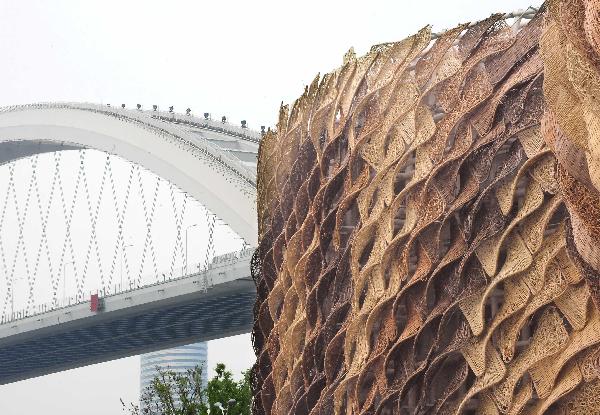EU shares technology with China at Expo
Despite the sluggish economy, the EU and its 27 member countries are participating in the 2010 Shanghai World Expo and are illustrating concepts of low carbon and sustainable development through their high-tech pavilions.
Their pavilions are impressive, and even more so considering they built them with natural materials to practice the principle of environmental protection. Here are some examples:
Portugal decorated its pavilion's exterior curtain walls and interior attaching veneers walls with cork, a domestically sourced recyclable and environmentally friendly material;
Spain's pavilion is assembled with more than 8,000 wicker panels handmade by craftsmen in Shandong Province, each one unique in design;
|
|
|
The Spain Pavilion is seen beside the Lupu Bridge over the Huangpu River in the World Expo Park in Shanghai. The building, nicknamed "rattan basket", has its steel frame dressed in 8,542 wicker panels in brown, beigem and black, which creat a beautiful scene. [Xinhua Photo] |
Norway constructed its pavilion with 15 model trees made from Norwegian pine trees and Chinese bamboo.
Newly developed environmentally friendly materials are also employed. The silver membrane of the Finnish pavilion is a new composite material; the "net" that covers the French pavilion is made of special concrete; and Sweden built its pavilion with fireproof glulam (glue-laminated timber).
Besides the high-tech show, designs of many EU pavilions are mixed with Chinese elements. The exterior wall of the Polish pavilion has a paper-cut pattern, a traditional Chinese craft, and the Dutch pavilion was constructed in a figure eight – a lucky number that suggests fortune in Chinese culture.
To implement the concept of sustainable development, many pavilions can be easily dismantled and reconstructed, and natural resources like rainfall and sunlight are used – a high-tech umbrella at the Dutch pavilion can amass a great deal of energy from the sun.
Sino-EU science and technology cooperation is vital, especially in energy sector. Practical cooperation in renewable energy, clean coal, bio fuel and energy efficiency began on April 30, 2010, when the EU-China Clean Energy Center was officially launched. Furthermore, leaders will meet at the China-EU Energy Conference during the Expo and it's expected to generate more discussion points and propel bilateral cooperation.
Obviously, EU wants to strengthen cooperation with China in the fields of science and technology, and Shanghai Expo provides a rare chance.
Jia Ruixia is a researcher with the Institute of European Studies, Chinese Academy of Social Sciences.
(This article was translated by Fan Junmei.)
 0
0 








Go to Forum >>0 Comments